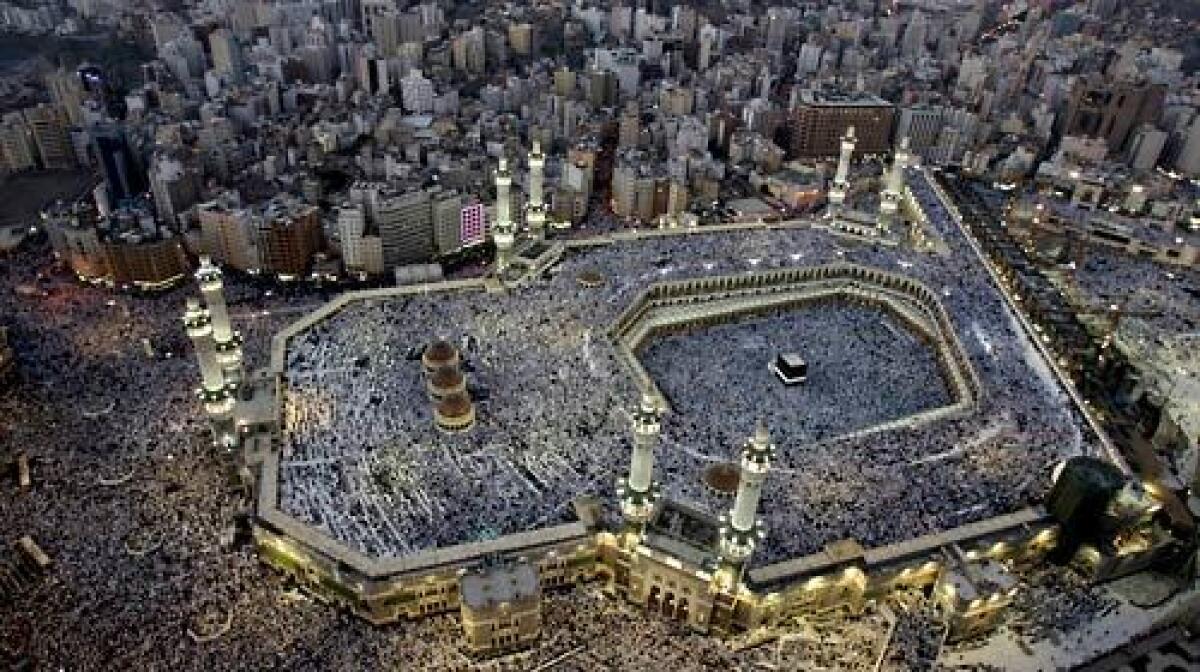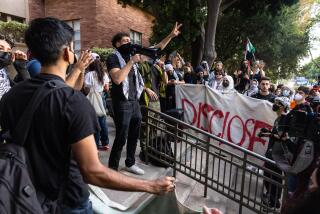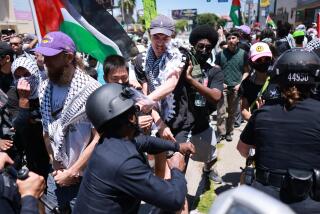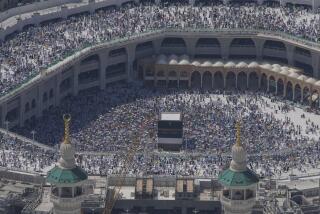Personal trek, with millions

- Share via
If this were Lebanon, Raef Hajjali would have returned from Saudi Arabia to a mini-parade of family and friends, a nice long rest and new social standing in the community.
Relatives and neighbors would have slaughtered a sheep in celebration and decorated his home with palm fronds. “The whole town would have been waiting,” he said.
Instead, he and his wife, Ellen Hajjali, returned home to Altadena a few weeks ago to minimal fanfare, and he was back at work the next day. He didn’t last long.
A construction engineer helping remodel the neonatal wing of a hospital in Torrance, he was coughing so much that his co-workers sent him home. How to explain that he was still fending off the severe chest cold known as the hajj flu?
But how to explain what it’s like when 2.3 million people gather, as Ellen put it, at the House of Allah?
“It’s impossible to explain what you get out of it,” Raef said.
Raef and Ellen Hajjali were among about 40 Southern California Muslims who traveled in December to perform the exacting rituals of the hajj, the pilgrimage to Mecca that is the pinnacle of an observant Muslim’s life.
The pilgrims’ leader, Imam Moustafa Al-Qazwini, told them in November that they would be embarking on an “amazing journey.” Now, back home, having had months to reflect, the pilgrims say the journey was more rewarding and punishing, more joyful and miserable than they could have imagined.
In the midst of the hajj, several pilgrims wondered why nobody had told them it would be so difficult. Several had attended weekly “hajj lessons” at the Islamic Educational Center in Costa Mesa, but they still weren’t prepared for the raucous crowds, the hours of trudging through the desert on blistered feet, the mayhem that pushed them to their physical limits.
The chaos followed one of the truly peaceful moments on the pilgrimage, the noon-to-sunset vigil on Mt. Arafat that is the centerpiece of the hajj. During the vigil, each hajji, as pilgrims are called, speaks directly to God -- confessing sins, asking forgiveness and seeking a clean slate for the future.
Islamic practice places a premium on group worship. Praying at the mosque, shoulder to shoulder in tight lines, is preferable to praying at home. But on Arafat pilgrims interact with God as they wish.
Many hajjis climbed the rough slopes of the Mountain of Mercy -- where tradition holds that Muhammad gave his last major sermon -- spread their hands and gazed skyward, some in tears. Others, including Ellen, ran down lists of friends and family, quietly praying for each person’s health and safety.
As night fell and the vigil ended Dec. 18, the hajjis had to travel about five miles to the desert plain of Muzdalifa to gather pebbles for the most dangerous part of the hajj, a ritual known as the Stoning of the Devil.
Things fell apart quickly. The buses chartered by the Costa Mesa pilgrims left late and then came to a standstill with thousands of other overloaded vehicles, many with hajjis perched on the roofs or clinging to the sides. Raef was among those on the roof of a bus, but after about six hours stuck on the roof in traffic, he and a few dozen others set off on foot.
“So we did start walking, and after four or five hours, we got there at 4:30 in the morning, which was about prayer time,” Raef recalled. “Nobody had time to take any naps. We had been up for a couple of days.”
After prayers, the group began another walk of about five miles to Mina, site of the stoning. Raef had not seen his wife for hours and became concerned. He did not know she was still trapped miles behind on a bus with other female pilgrims.
It took Raef, 51, several hours to hike to the valley of Mina. The ritual is based on the tale of Abraham throwing stones to ward off Satan, who was urging him to defy God’s order to sacrifice his son.
Mina was a place many pilgrims had been dreading. The mass deaths that periodically strike the hajj almost always happen there. The dangers inherent when millions of people attempt to perform the same rites at the same time are so well known that the pilgrims followed advice in their hajj class and made wills before leaving home. After a stampede in 2004 that killed 251 hajjis, the Saudi authorities remade the Mina complex into something resembling a multistory parking garage. Three stone pillars symbolizing Satan were replaced by large walls that could be approached from each of three floors.
Chaos persisted, despite the changes. Hajjis shoved and jostled to get near the walls. Those near the front of the crowd were pelted by badly aimed pebbles thrown from the back.
Many of the hajjis acted as if Satan really were before them, violently attacking the walls with rocks, sandals and verbal abuse.
Raef emerged from the scrum disheveled and wearing mismatched sandals. One of his flip-flops had come off and he was terrified of falling if he bent down to retrieve it. So he slipped his foot into a sandal lost by another hajji.
It was around noon Dec. 19, roughly 36 hours after they had donned white ihram robes, which signified the sanctified state of pilgrimage. The robes were now dirty from desert dust and sweat.
Raef and another pilgrim, Hakim Jennane of Long Beach, were still desperately trying to contact their wives.
To Raef, the scene was what he had been led to expect: “the day of judgment, where millions of people are just walking together in groups.”
The rest was a blur. Qazwini, the Southern Californians’ leader, rushed his 20-year-old son, Mahdi, to a doctor after he fell violently ill. Some pilgrims wandered hopelessly through the Mina crowds, unable to even sit on the sidewalks without being approached by Saudi police officers yelling, “Move hajji, move!”
It took more than 24 hours to confirm the sacrifice of a sheep, conducted at a massive government-run slaughterhouse. Once that was done, the pilgrimscould remove their robes, and the men could have their heads shaved, a sign of completing the hajj and starting afresh in life. Women do not have their heads shaved, but a lock of hair is snipped.
Ellen finally found Raef after about 20 hours on the bus. She and other women had missed Mina entirely but were relieved to learn that their hajj was valid because they had performed the Arafat vigil. Other rituals could be performed later or compensated for in various ways -- through extra prayers, slaughtering additional sheep or having a step performed by a proxy.
After the Southern Californians reunited at their hotel in Mecca, Qazwini, 46 and a hajj veteran, was oddly serene. “It was more disorganized than in previous years,” he said in understatement. “People may perceive this as a negative thing. But I really enjoyed it.”
A sort of immediate nostalgia set in as everyone got some rest. The pilgrims swapped war stories. The men limped comically on sore feet and chafed thighs. They laughingly compared freshly shaved heads and wondered how their new look would be received back in America.
For many, the warm feelings were undermined by the thought that they would be leaving soon -- that they would no longer be a short taxi ride from the Kaaba, the cube-like building that is surrounded by the Grand Mosque.
Long before Islam, the granite Kaaba was the centerpiece of an annual pagan religious festival. In 632, Muhammad performed the hajj as the head of the young Muslim nation, delivered a venerated sermon on Arafat and adopted the Kaaba as the holiest site in Islam. He died a year later.
In their last four days in Saudi Arabia, the pilgrims returned often to the Kaaba for the tawaaf, circling the building counterclockwise seven times. The Southern Californians had performed their first tawaaf several days earlier and initially found the crowds overwhelming, even frightening.
But each return felt easier, more spiritual. Ellen, 46, liked to go to the mosque’s upper floors and watch the masses circling on the marble pavement below.
Peeking through the white of their ihram robes were splashes of color -- often ribbons or scarves women wore to help groups keep together -- and she found it fascinating to watch “the sea of people all there for the same purpose.”
In a way, the scene symbolized Islam worldwide. When Muslims pray five times a day, they face the Kaaba, so across the globe Muslims in ever-growing concentric circles focus their energies on this one spot.
Using modern American slang to describe the ancient ritual, Hassan Badday, 30, a recent medical school graduate from Claremont, recalled some of his happiest times as “just sitting in front of the Kaaba after the hajj and just chilling.”
Badday has declared himself a “hajj addict” and has begun to understand why earlier hajj veterans hadn’t revealed how difficult it would be.
“You can count on one hand the number of times you’ve felt absolutely happy with yourself,” he said. “Maybe that’s why I want to go back -- to try to extend that moment.”
New hajjis are said to be reborn, their sins forgiven. But there’s an implicit bargain in that clean moral slate: They’re supposed to work on their flaws and focus more on their faith.
“There are some lasting habits that I’ve changed,” said Badday. “I still have some work to do in terms of trying to be a better Muslim.”
Jennane, 50, a Moroccan-born business analyst from Long Beach, used to drink occasionally but said he’s sworn it off. “It wouldn’t feel right,” he said. “I’m a hajji now.”
Like Badday and the Hajjalis, he’s found that the challenges of the hajj become “less important in your mind. The spiritual stuff takes over from the tiredness, the sickness, everything.”
Jennane’s wife, Yasmina, 42, said she feels “totally different, a lot more mature.” She prays more regularly and tries to avoid telling little white lies or losing her temper. A more dramaticchange: She now wears a veil.
And for Ellen, who had converted from Roman Catholicism as an adult, the power of the hajj seems to grow as days pass.
“Imagine that you have been invited to the House of Allah,” Ellen told a group at the Costa Mesa mosque upon her return.
To her surprise, she said, her most emotional moment came “in the middle of the night on a crowded bus” on the hellish trip from Mt. Arafat to Muzdalifa.
It was about 2 a.m. She had emerged from the Mt. Arafat vigil feeling strangely detached.
But that night the spiritual power of where she was and what she was doing hit her. She felt “that oneness with Allah in a bus of about 50 people.” Sitting on the bus, she put her head on her forearms and quietly sobbed.
More to Read
Sign up for Essential California
The most important California stories and recommendations in your inbox every morning.
You may occasionally receive promotional content from the Los Angeles Times.










